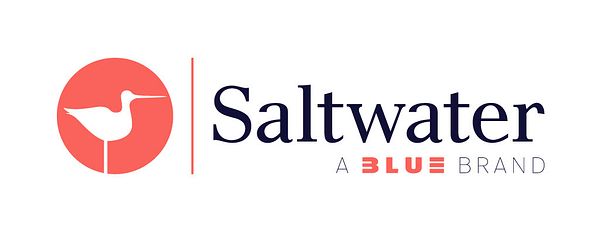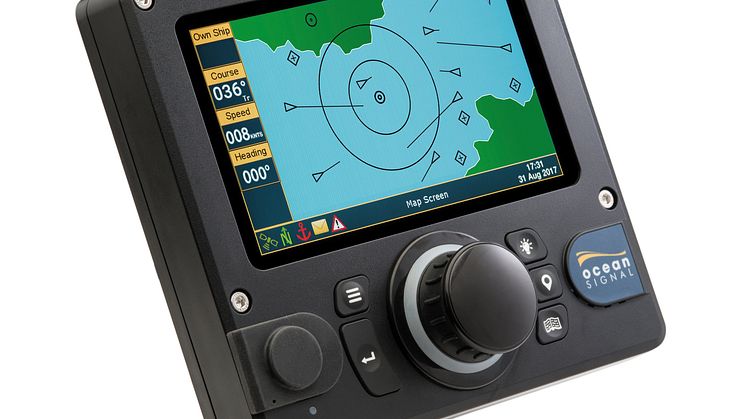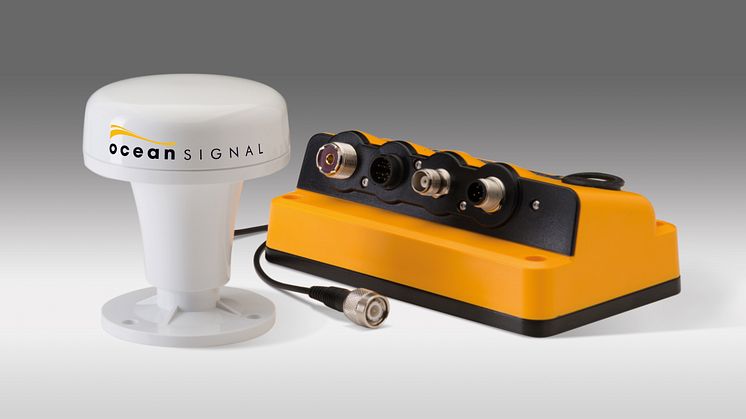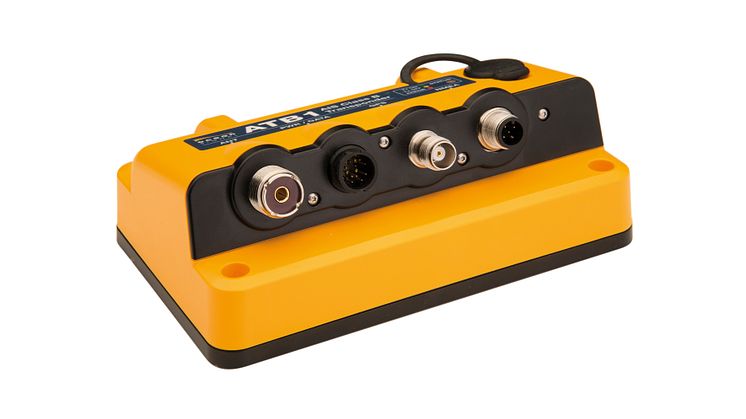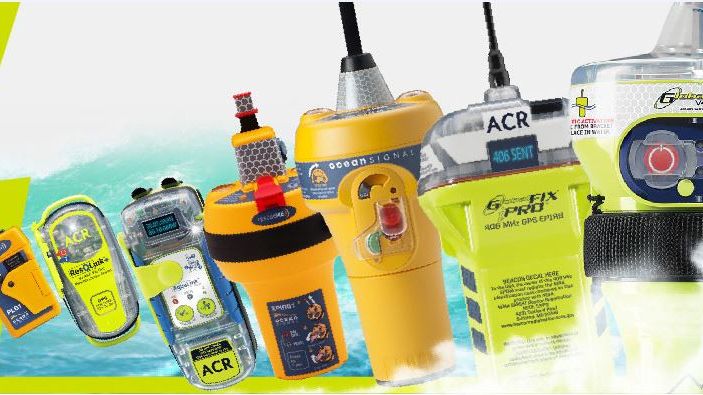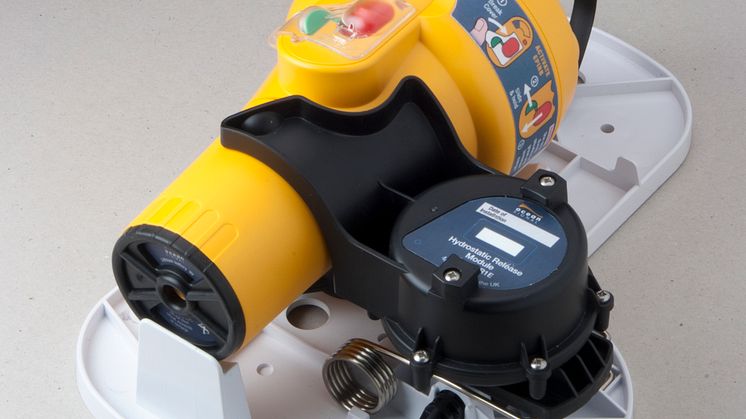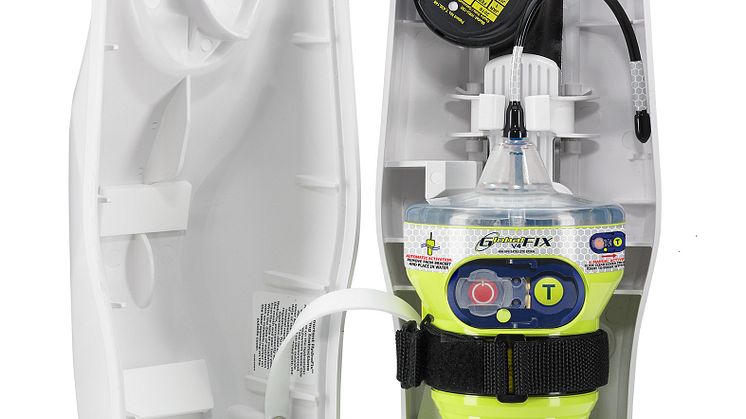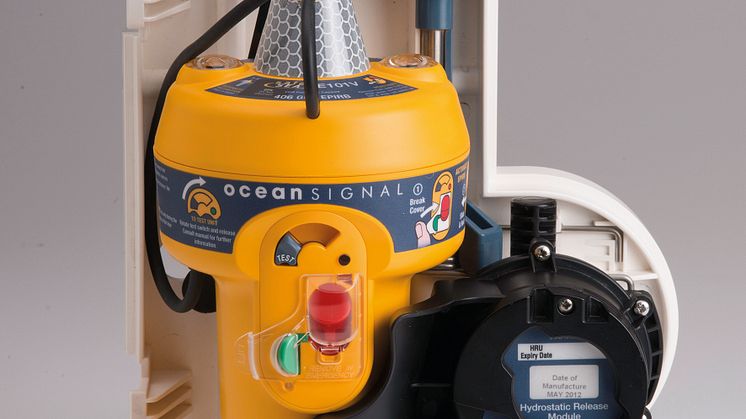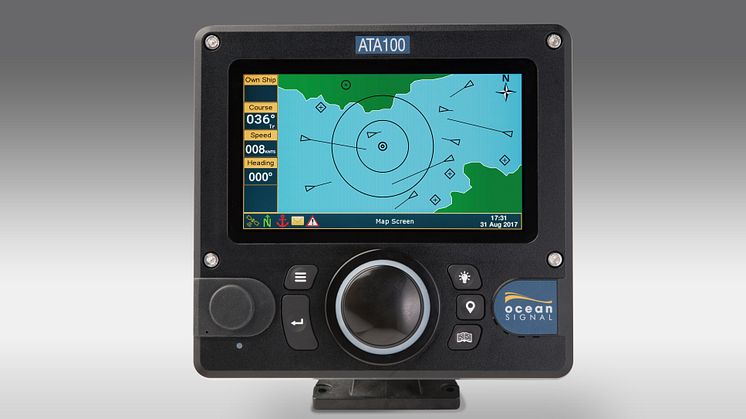
Press release -
Ocean Signal and ACR Electronics: SMM 2018 Press Kit
Please find below the Ocean Signal and ACR Electronics press kit for SMM 2018, as follows:
1. Ocean Signal Introduces ATA100 Class A AIS Transponder
2. Ocean Signal Introduces ATB1 Class B AIS Transponder
3. ACR Electronics and Ocean Signal Highlight MEOSAR-Compatible Beacons
4. Ocean Signal Presents E101V Float-Free EPIRB with VDR Memory Capsule
SMM 2018, 4th to 7th September, Hall B1.OG Stand 510
1) Ocean Signal Introduces ATA100 Class A AIS Transponder
Ocean Signal is introducing the ATA100 Class A AIS Transponder, a combined SOLAS and Inland approved solution capable of exchanging dynamic and static ship data with other AIS systems to aid collision-avoidance and improve safety for commercial vessels.
Developed to meet the latest IMO carriage requirements and IEC standards, the new device incorporates Ocean Signal’s trusted technology within a compact design which is easy to use and simple to install.
The ATA100 is the only Class A AIS transponder available rated to the IPX7 waterproofing standard and features a 7-inch high-intensity, full-colour, rapid-response LCD to clearly display real-time marine traffic information. The coastline map and radar views have various orientation display options, whilst a standard target list display can be customised according to preference to provide immediate detailed information about nearby vessels.
The Ocean Signal Class A AIS has integrated Wi-Fi and USB interfaces for PC and tablet connection and is user intuitive, featuring large illuminated keys and easy-to-grip jog stick. The simple-to-use AIS message-sending functionality ensures safety related messages can be quickly delivered or received by the user, while an instant message and alarm function provides immediate notification of any potential problems or hazards.
Occupying a minimal amount of bridge space, the ATA100 is supplied with pilot plug and is suitable for either flush panel or free standing mounting for easy installation into almost any position or location.
Data such as location, speed over ground and course over ground is calculated automatically using the integrated 99-channel GPS receiver, while the static and voyage related data such as MMSI, call sign and identity, type of ship, destination and ETA is effortlessly programmed into the AIS transponder via a user-friendly intuitive menu interface.
Neil Jordan, Managing Director, Ocean Signal, said: “The ATA100 combines our proven technical know-how with the fluid product design Ocean Signal’s customers have come to expect to create a fully compliant, single unit solution which is easy to use and install on a wide range of vessels. It has been meticulously designed to allow operators to access and interpret the information provided by AIS to simplify navigation and improve safety, with intuitive operation and features such as the large clear display, versatile mounting options and easy-to-grip jog stick.”
As expected, this new Class A unit is compatible with Ocean Signal’s award-winning rescueME MOB1 man overboard AIS/DSC device and is programmable to accommodate up to 30 MOB units, providing immediate notification in the event that a MOB1 should be activated.
The ATA100 Class A AIS Transponder is the latest product offering in Ocean Signal’s comprehensive portfolio of essential sea-safety equipment developed and manufactured in the UK for the commercial maritime market, adding to the SafeSea range of GMDSS products, including the E100 and E100G EPIRB, S100 SART and V100 handheld VHF radio, as well as the M100 and M100X professional MSLD and E101V float-free EPIRB with integrated voyage data record memory capsule.
For further information about Ocean Signal’s products, visit Hall B1.OG Stand 510 during SMM or go to www.oceansignal.com.
Ends
2) Ocean Signal Introduces ATB1 Class B AIS Transponder Incorporating Superior SOTDMA Technology and 5W Output Power
Ocean Signal is introducing the ATB1, a powerful Class B AIS Transponder incorporating the superior SOTDMA technology and 5W output power to ensure increased visibility and navigational safety.
The new fully-compliant Ocean Signal AIS unit uses the SOTDMA (Self Organised Time Division Multiple Access) scheme to provide enhanced navigational safety and added assurance that the vessel will be seen day or night. This complex AIS technology, which ensures increased priority for position reports with no loss or delay of transmission, has been incorporated within the ATB1 to offer commercial operators a high strength, yet affordable, Class B device for aiding collision avoidance and providing peace of mind in areas of high traffic or poor conditions.
The Ocean Signal ATB1 has a faster reporting rate and higher output power than standard CSTDMA (Carrier Sense TDMA) Class B units, sending AIS transmissions every five seconds instead of the CSTDMA two transmissions per minute. The unit’s 5W output power, compared to the standard 2W, allows the transmissions to reach further.
Communication and safety at sea specialist Ocean Signal’s advanced proven technology ensures the ATB1’s AIS transmissions provide the most accurate representation of the vessel’s position at all times. With 99 acquisition channels and 33 tracking channels, the powerful internal multi-GPS receiver continuously updates vessel information, including position, speed, course and heading, for accurate global positioning.
Other vessel information such as identity, call sign, type and dimensions, and MMSI is uploaded to the ATB1 via WiFi directly from Ocean Signal’s user-friendly mobile app or website to be stored for automatic transmission.
The ATB1 also receives and interprets AIS messages from other AIS-equipped vessels within range, which can then be relayed to other navigation devices such as chart plotters, laptops or mobiles using the ATB1’s NMEA 0183, NMEA 2000, USB or Wi-Fi outputs.
Providing assurance that the ATB1 is functioning with continuous AIS transmission and optimal performance, a multi-colour LED indicator light on the ATB1 signals the on-going operational status of the unit.
Easy to use with accessible connections, the ATB1 features a sleek, yet rugged, waterproof design that is high on performance and low on energy consumption. It is quick and simple to install and is supplied complete with an external mount GPS antenna, ready to upload vessel information using a mobile phone, tablet or PC.
The new Class B AIS unit is compatible with Ocean Signal’s award-winning rescueME MOB1 man overboard AIS/DSC device, providing immediate notification in the event that a MOB1 should be activated.
Neil Jordan, Managing Director, Ocean Signal, said: “The ATB1’s increased power and transmission frequency and use of the SOTDMA scheme open up the exceptional capabilities and benefits of AIS technology to more people, offering a level of transmission reporting priority only previously available with a Class A AIS unit, enabling more operators to see and be seen for peace of mind, especially in low visibility or congested areas.”
The ATB1 Class B AIS Transponder is the latest device in Ocean Signal’s comprehensive portfolio of essential sea-safety equipment developed and manufactured in the UK for the maritime market. It adds to the new Ocean Signal ATA100 Class A AIS Transponder, a combined SOLAS and Inland approved solution for superyachts and commercial vessels.
For further information about Ocean Signal’s products, visit Hall B1.OG Stand 510 during SMM or go to www.oceansignal.com.
Ends
3) ACR Electronics and Ocean Signal Highlight MEOSAR-Compatible Beacons
ACR Electronics and Ocean Signal are showcasing their comprehensive range of leading MEOSAR-compatible distress beacons at this year’s SMM.
Featuring the latest advanced technology, the ACR and Ocean Signal 406MHz beacons will offer even greater life-saving capabilities than before due to the effect of Cospas-Sarsat’s next-generation Medium-Earth Orbit Search and Rescue (MEOSAR) system, which is set to reach full operational capacity in the next few years.
Estimates indicate that when using the next-gen network, anyone activating a GPS-enabled ACR or Ocean Signal EPIRB or PLB can expect their beacon to be located within 100 metres (328 feet), 95% of the time, within 5 minutes of the distress signal instead of taking up to the one to two hours typical with the current LEOSAR and GEOSAR system.
Mikele D’Arcangelo, Vice President of Global Marketing & Product Management, ACR Electronics, said: “The new MEOSAR network is poised to have a huge impact on search and rescue that will ultimately result in more lives saved. Anyone using our compatible beacons can expect to be located with even more accuracy and faster than before.
“Such a ground-breaking update in technology means it will be even more valuable for commercial owners and operators to include EPIRBs for the vessels and PLBs for crew within the on-board safety equipment in the years ahead. We are raising awareness about the development and the value it adds to all our beacons, including our Category 1 automatically-deployed, float-free EPIRBs, so that operators can make an informed decision about why they should carry an EPIRB and a PLB.”
All ACR Electronics and Ocean Signal beacons, including the ACR GlobalFIX V4 and GlobalFIX Pro and iPro EPIRBs, the ACR ResQLink PLBs, plus the Ocean Signal SafeSea E100 and E100G EPIRBs, rescueME EPIRB1 and rescueME PLB1, are compatible with the next-gen satellites, ensuring they will offer the near instantaneous signal detection and transmission enabled by the global MEOSAR satellite transponders and upgraded ground-station components. For commercial vessels that require a float-free EPIRB that automatically deploys and activates when submerged in water, the ACR Electronics GlobalFIX V4 and GlobalFIX Pro, and Ocean Signal SafeSea 100G float-free EPIRBs feature Category 1 hydrostatic release brackets or housing options.
ACR and Ocean Signal EPIRBs are reliable, innovative, compact and user-friendly with exceptional battery lives, and feature robust internal GPS to fix the exact location of the vessel in distress within 110 to 120 metres accuracy. The coordinates are then transmitted via a 406MHz distress signal to search and rescue authorities, with a 121.5MHz homing signal further guiding searchers to the position.
24 EU launched Galileo navigation satellites will carry second generation SAR transponders for the Cospas-Sarsat system at Medium Earth Orbit altitude to supplement the existing LEOSAR (Low Earth Orbit) and GEOSAR (Geostationary Orbit) systems. The increased number of satellites offers much faster signal detection, greater location accuracy, strengthened coverage and greater reliability to improve alerting times for distress beacon owners in emergency situations.
When complete there will be 72 MEOSAR satellites positioned at Medium Earth Orbit altitude, over six times the number of existing satellites in orbit. MEOSAR relays more beacon signals to ground stations using a technique known as ‘bent pipe’ which is an average of 46 minutes faster than LEOSAR. The network of ground stations, called MEOLUTs (Local User Terminals), along with multiple antenna systems, results in close to 100% reliability and near instantaneous global coverage.
For further information about Ocean Signal and ACR Electronics’ products, visit Hall B1.OG Stand 510 during SMM, and go to www.acrartex.com and www.oceansignal.com.
Ends
4) Ocean Signal Presents E101V Float-Free EPIRB with VDR Memory Capsule
The Ocean Signal E101V float-free EPIRB with integrated voyage data recorder (VDR) memory capsule is designed according to the latest VDR performance standards as a leading solution for commercial vessels of 3000+ gross tonnage. Developed in collaboration with VDR specialist AMI Marine, the E101V is Cospas Sarsat and MED certified and approved to IEC61097-2 as a float-free EPIRB with built-in memory capsule.
Enabling ship owners and operators to meet new mandates for VDRs as defined by IMO Resolution MSC.333(90), the Ocean Signal device can be easily integrated with a vessel’s VDR, a vital on-board system which helps to identify the cause of any accident, evaluate decision making on-board at the time of an incident, improve safety and also assist in accident avoidance, training and other areas of maintenance, monitoring and analysis.
The E101V features a dedicated float-free housing with improved hydrostatic release unit and automatic disconnection of the interface cable on release before 4m depth, ensuring the stored data can be easily and quickly retrieved in the event of an accident or incident.
With 406MHz Cospas Sarsat satellite alerting and 121.5MHz homing, the Ocean Signal device has an integral 66-channel GPS receiver, rather than the 22-channel GPS featured in other products, which ensures fast and accurate positioning as the device is able to acquire the position from a cold start by seeking all the satellites simultaneously to determine which are in view.
At 224mm x 110mm (440mm including antenna) and weighing just 985g, the E101V is significantly smaller and lighter than other products on the market, due to the use of low current technology developed by Ocean Signal for its current EPIRBs. For easy maintenance, the compact design still allows easy accessibility without damaging the product. The release housing size is just 293mm x 196 x 126.
The E101V has a flexible blade antenna and twin high intensity strobe light. As with all Ocean Signal products, it has a market-leading battery life of five years and a two-year warranty. The battery operating life is greater than 168 hours at -20°C. The separate VDR storage module incorporated in the E101V features the standard memory capacity of 64GB.
The Ocean Signal device is available on an OEM basis to selected VDR manufacturers and suppliers for integration with their own VDR systems. The E101V is also supplied with AMI’s new regulation X-Series VDR which incorporates IEC61162-450 network protocol, applicable to the collection, storage and playback of important data, and exceeds the requirements of the 2014 IEC 61996-1 Ed 2.0 regulations. Completely European in its manufacture, all of the equipment is designed and built in the UK and Germany, with all but the fixed capsule being of an AMI Marine bespoke design.
James Hewitt, Ocean Signal Sales and Marketing Manager, said: “The development of the E101V is a result of meticulous design and expert input from the specialist engineers at Ocean Signal and AMI Marine. The result is a product which incorporates a number of significant features and is a trusted and approved solution for new generation VDRs which comply with the latest IMO mandates.”
Martin Cox, sales director at AMI Marine, added: “The introduction of the IMO resolution, along with IEC61996-1 Ed 2.0, heralded a new chapter in VDR requirements with both a fixed and float-free capsule required, each holding a minimum of 48 hours of data. The E101V float-free capsule is a welcome addition to the AMI X-VDR system, allowing for easier and cheaper shipping with its refined compact design.”
For further information about Ocean Signal’s products, visit Hall B1.OG Stand 510 during SMM or go to www.oceansignal.com.
Ends
Related links
Topics
Categories
About Ocean Signal
Communication and safety at sea specialist Ocean Signal™ is dedicated to providing the technology and quality of product that will set industry standards.
Ocean Signal’s product portfolio consists of the rescueME range of products, including the rescueME PLB1, the rescueME MOB1, the rescueME EPIRB1 and the rescueME EDF1 electronic distress flare, plus the AIS Alarm Box, and the SafeSea range of GMDSS products, including the E100 and E100G EPIRB, S100 SART and V100 handheld VHF radio, as well as the M100 and M100X professional MSLD and E101V float-free EPIRB with integrated voyage data record memory capsule. They provide both recreational and commercial mariners with simple to use, compact and affordable life-saving solutions. All products are engineered by a highly experienced team of marine electronics professionals.
Ocean Signal products are trusted by high-profile sailors, rowers, surfers and powerboat racing teams. Providing some of the world’s best competitors and adventurers with vital safety and communication devices, the rescueME MOB1 and rescuePLB1 were integrated with the Spinlock lifejacket and personal equipment packs for the crews in the Volvo Ocean Race 2017-18 and the rescueME MOB1 was also selected to enhance safety standards for crew taking part in the Clipper 2017-18 Round the World Yacht Race. Ocean Signal has also sponsored the crew of Simply Fun with rescueME MOB1s, rescueME PLBs and a rescueME EPIRB1 in the 2016 Rolex Sydney Hobart Yacht Race, the 16-man crew of Triton with rescueME MOB1s in the 2015 Rolex Sydney Hobart Yacht Race,record-breaking sailor Andrea Mura in the single-handed OSTAR race, Mini Transat 2015 solo sailor Lizzy Foreman, ocean rowing teams including Ocean Valour, Ocean Brothers and Carbon Zerow and solo rower Lia Ditton, Venture Cup offshore powerboat race team Cinzano, kite racer Gina Hewson and canoeist Adam Weymouth.
Safety and communication products from Ocean Signal offer exceptional value, meeting or exceeding international technical and safety standards. Careful design and innovation provide commercial shipping, fishing and recreational users the confidence that their Ocean Signal equipment will work to, and beyond, their expectations when it is needed most.
About ACR Electronics, Inc.
ACR Electronics, Inc., designs and manufactures a complete line of safety and survival products for the brands ACR, ARTEX, Skytrac, Flight Data Systems, Ocean Signal, United Moulders (UML), and NAL Research. Available products include Emergency Position-Indicating Radio Beacons (EPIRBs), Personal Locator Beacons (PLBs), ARTEX Emergency Locator Transmitters (ELTs), Flight Data Monitoring, GADSS, Search and Rescue Transponders (SARTs), Strobe Lights, Life Jacket Lights and Inflators, Boat Search Lights, and other associated safety accessories. ACR’s facility Quality Management System (QMS) is certified by TUV USA and is certified in accordance with AS9100C / ISO 9001:2008 standards. Recognized as a world leader in safety and survival technologies for over 60 years, ACR has provided life-saving equipment to the marine, outdoor, aviation industries as well as to various government agencies worldwide. For more information go to www.ACRARTEX.com
